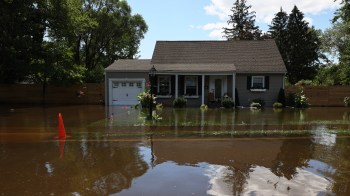"Dead Zone" threatens shrimp fishery
Share Now on:
"Dead Zone" threatens shrimp fishery
PHOTO GALLERY: The Dead Zone — Part 1
KAI RYSSDAL: Slowly, very slowly, but steadily the Gulf Coast is coming back from Hurricane Katrina. Workers have returned and businesses have reopened. Some homes are being rebuilt. But out on the water not much has gotten better for Louisiana shrimpers. Boat owners are facing high fuel costs. And a flood of cheap imported shrimp. So it might not take another hurricane to deal the final blow. Sam Eaton has that story from the Marketplace Sustainability Desk.
SAM EATON: A strange thing happens every so often along the Louisiana coast. Something known as the dead zone creeps into the shallow bays and bayous like an invisible monster from the deep. At the shrimp docks in Lafitte it’s the stuff of legend. Fourth-generation shrimp fisherman A.J. Fabre has seen it first-hand.
A.J. FABRE: What happens is it just depletes all oxygen. So there’s nothing, nothing that can live without the oxygen.
There is a scientific explanation. Spring runoff from the Mississippi is loaded with nitrogen-based fertilizers from farms. The fertilizer has the same effect in the Gulf as it does on the Midwest fields it came from. But instead of giving corn a growth spurt, the nitrogen fuels massive algae blooms that then die and suck all of the oxygen out of the water as they decompose. Fabre says the science makes perfect sense, but watch the sea life’s reaction to the dead zone and it’s more the stuff of science fiction.
FABRE: Crabs get on top the water and wanta jump out of the water. Shrimp is jumping, fish is jumping. I mean, it’s . . . they’re smothering. For a human being to understand it, just — if you’d be smothering, what would you do? — and they panic. The seafood panics.
These strange events have been nicknamed “jubilees” by locals because anyone with a net can catch as many shrimp and crab as they have the strength to haul in. But the apparent bounty on the edge of a dead zone is deceiving when you consider the vast, fish-free desert that stretches for miles behind it.
Doug Daigle directs the Environmental Protection Agency’s dead zone task force for the Lower Mississippi Basin:
DOUG DAIGLE: The trend for this hypoxic or low-oxygen zone that forms every summer has been that it’s roughly doubled in size over the last decade. And it’s getting up to a point now where it’s . . . For a number of years it’s been the size of several small New England states.
Daigle says the risk is that if the dead zone continues to grow, it could eventually cause a complete collapse of the Gulf Coast ecosystem. At stake, among other things, is Louisiana’s $2.3-billion fishery, second only to Alaska in terms of commercial sales.
Fifteen miles off the Louisiana coast a team of scientists is dropping electronic sensors over the side of their research boat. They’re testing for salinity, temperature and oxygen.
Nancy Rabalais with the Louisiana Universities Marine Consortium has been studying the dead zone for decades. She says the problem, much like global warming, could eventually affect everyone.
NANCY RABALAIS: It’s a symptom of nutrient over enrichment that is occurring worldwide. We just happen to have one of the big poster childs here in the Gulf of Mexico because it is so large.
The Gulf Coast dead zone has been growing in size ever since synthetic nitrogen fertilizers were first introduced to farms post World War II. The latest figures peg the annual nitrogen runoff into the Gulf in excess of 2.2 billion pounds. A study by the National Marine Fisheries Service found that the annual shrimp catch has dropped nearly a quarter in recent years.
Shrimper A.J. Fabre, who’s also the head of the Louisiana Shrimp Association, says it’s easy to see why. He says before the dead zone became a problem, shrimp boats used to fish a much larger area.
FABRE: Now what’s happening, you got the offshore fleet that can’t make a living offshore. They forced to come make a living right there on the beach with us. And we catching a smaller product than we used to catch.
Fabre says combine the intense fishing close to the shrimps’ breeding grounds with the loss of habitat created by the dead zone and Louisiana’s valuable shrimp industry could become an entry in the history books.
FABRE: I can’t see any future. I got four sons. Only one son is in the business. The other three sons is working for the oil company. I mean, it’s no future.
Fabre, a compact man with greased black hair and a graying mustache, lights a smoke and goes back to work on his broken-down boat. He says the government has known about the dead zone for more than 30 years. It just lacks the political will to address the cause. Fabre says in the grand scheme of Washington politics the Louisiana fisherman is expendable.
In Lafitte, La., I’m Sam Eaton for Marketplace.
There’s a lot happening in the world. Through it all, Marketplace is here for you.
You rely on Marketplace to break down the world’s events and tell you how it affects you in a fact-based, approachable way. We rely on your financial support to keep making that possible.
Your donation today powers the independent journalism that you rely on. For just $5/month, you can help sustain Marketplace so we can keep reporting on the things that matter to you.


















